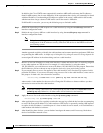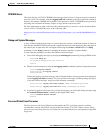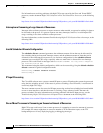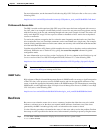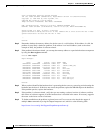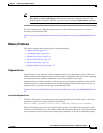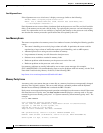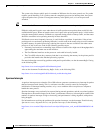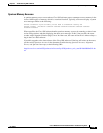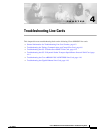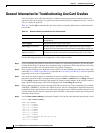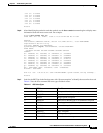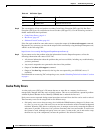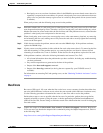
3-18
Cisco uBR10012 Universal Broadband Router Troubleshooting Guide
OL-1237-01
Chapter 3 Troubleshooting PRE-1 Modules
Troubleshooting Common System Problems
The system also allocates public pools in a number of different sizes for more general use. If a packet
requires special handling, or if a packet cannot be completely processed at interrupt time, the system
copies the packet into a portion of contiguous memory in the public pool, so it can be processed
switched.
Tip Use the show buffers command to display the current status of the router’s particle pools.
Fallbacks with particle pools occur when bursts of traffic produce more packets than would fit in the
available buffer space. When an interface runs out of space in the private particle pools, it falls back to
using the normal public memory. Fallbacks are expected during periods of bursty traffic, and the router
should be considered to be operating normally in these situations.
If fallbacks occur more frequently, however, it could indicate a problem. In particular, if the private
particle pools are consistently producing fallbacks, it could result in the router using excessive amounts
of public memory for packet processing, reducing the resources that are available to the other router
processes. If this is the case, look for the following possible causes.
• Extremely fast interfaces are handling large volumes of traffic with a high rate of throughput that is
approaching the maximum rate on the interface.
• The Fast Ethernet interfaces on the processor card could be heavily loaded.
• The Cisco IOS software has a memory leak that is not releasing the memory in the private particle
pool after the interface has finished processing a packet.
For more information on resolving problems with particle pool buffers, see the document Buffer Tuning,
at the following URL:
http://www.cisco.com/warp/public/63/buffertuning.html
Also see the document Troubleshooting Buffer Leaks, at the following URL:
http://www.cisco.com/warp/public/63/bufferleak_troubleshooting.html
Spurious Interrupts
A spurious interrupt occurs when the Cisco IOS software generates an unnecessary interrupt for packet
that has been processed already. This is a software error that is usually caused by an improper
initialization of interrupt handling routines, or by a race condition where two processes compete to
handle the same process.
Spurious interrupts can occasionally be expected during normal operations, and the occasional spurious
interrupt has no discernible impact on the router’s performance. However, action might be needed if the
number of spurious interrupts is high or increasing, and performance is being degraded, with packets
being dropped.
For information on resolving the problem with spurious interrupts, see the document Troubleshooting
Spurious Accesses, Alignment Errors, and Spurious Interrupts, at the following URL:
http://www.cisco.com/en/US/products/sw/iosswrel/ps1828/products_tech_note09186a00800a65d1.sht
ml



